Understanding the Nexus Between Inflammation and Autism
Autism Spectrum Disorder (ASD) is a complex neurodevelopmental condition increasingly understood through the lens of immune dysfunction and inflammation. Recent advances reveal how altered immune responses, neuroinflammatory processes, and biochemical pathways contribute to the development and manifestation of autism. This article delves into the emerging scientific evidence linking inflammation with ASD, alongside an overview of therapeutic approaches such as Applied Behavior Analysis (ABA) that support individuals living with autism.
The Immune System and Autism: Cytokine Alterations and Immune Dysregulation

What is the evidence for immune system involvement in ASD?
Research indicates a significant role of the immune system in autism spectrum disorder (ASD), particularly through altered cytokine profiles. Individuals with ASD often show lower serum levels of interleukin-10 (IL-10), an anti-inflammatory cytokine that typically helps regulate immune responses. This reduction suggests impaired immune regulation among ASD patients.
Role of cytokines IL-10 and IL-8 in ASD
Alongside IL-10, levels of interleukin-8 (IL-8), a pro-inflammatory chemokine, are also reduced in ASD, pointing to disruption in pro-inflammatory signaling pathways. These cytokines—IL-10 and IL-8—play crucial roles in balancing the immune system’s inflammatory and anti-inflammatory mechanisms, and their altered levels highlight a complex immune imbalance rather than simply heightened inflammation.
Immune dysregulation as a factor in ASD pathogenesis
The observed cytokine alterations support the broader hypothesis that immune dysregulation contributes to ASD development. This dysregulation manifests as an abnormal inflammatory response that may influence neurodevelopment and neuroinflammation, both critical in ASD pathogenesis.
Correlations between inflammatory markers CRP, IL-10, and IL-8 in ASD
Furthermore, significant positive correlations between C-reactive protein (CRP)—an inflammation marker—and cytokines IL-10 and IL-8 in individuals with ASD suggest an active, yet disordered, inflammatory state. This relationship is distinct from that seen in typically developing controls, emphasizing unique immune activation patterns in ASD.
Variation in immune network interactions between ASD and controls
The interactions between immune markers differ notably between ASD patients and controls, implying altered immune network dynamics in ASD. Such differences underscore the complexity and heterogeneity of immune responses involved, indicating that immune alterations in ASD are not solely pro-inflammatory but involve a nuanced imbalance of immune signaling.
Overall, these findings illuminate how cytokines and immune dysregulation intertwine to influence ASD, with potential implications for diagnosis and therapeutic strategies aimed at modulating immune function.
Peripheral Cytokine Profiles as Potential Biomarkers for Autism

Diagnostic potential of IL-10 in ASD
Research has highlighted the anti-inflammatory cytokine IL-10 as a strong candidate biomarker for autism spectrum disorder (ASD). Serum levels of IL-10 are significantly lower in ASD patients, reflecting impaired immune regulation. Diagnostic testing shows that IL-10 has an area under the curve (AUC) of 0.968 in distinguishing ASD cases, indicating excellent accuracy and potential for clinical use.
Identification of inflammation-related protein biomarkers including IL-17C, CCL19, CCL20
Advanced proteomic techniques, such as Olink proteomics, have identified a panel of 18 inflammation-related proteins that are consistently upregulated in children with ASD. Among these, IL-17C, CCL19, and CCL20 stand out as promising biomarkers. IL-17C, in particular, has demonstrated strong diagnostic performance with an AUC of 0.839. These proteins are involved in key inflammatory pathways including the IL-17 signaling and cytokine–cytokine receptor interaction pathways.
Use of proteomics to differentiate ASD inflammatory profiles
Proteomics analysis enables a detailed profiling of inflammatory protein expression, providing insights into the dysregulated immune environment in ASD. This approach uncovers a complex pattern of cytokine changes rather than a simple pro-inflammatory state. The upregulation of specific chemokines such as CCL19 and CCL20 suggests alterations in immune cell communication and migration that may contribute to ASD pathophysiology.
Inflammatory cytokines association with ASD symptom severity
Correlations between inflammatory cytokine levels and behavioral assessments, such as the Social Responsiveness Scale (SRS), reveal a nuanced relationship between inflammation and social behavioral deficits in ASD. Some inflammatory markers show inverse correlations with symptom severity measures, indicating that the immune response in ASD is heterogeneous and may influence specific clinical features.
These findings collectively support the existence of peripheral immune signatures in ASD that can be leveraged for improved diagnosis. They also open avenues for personalized approaches targeting immune modulation in therapeutic development.
Neuroinflammation and Immune Cell Dysfunction in ASD Brain Tissue

Microglial Activation and Postmortem Brain Findings in ASD
Microglia, the brain's resident immune cells, show increased activation, density, and morphological changes in the brains of individuals with autism spectrum disorder (ASD). These alterations have been consistently documented in postmortem studies, indicating an ongoing neuroinflammatory process that may contribute to ASD pathology.
Morphological Changes in Cerebellar Neurons Affected by Inflammation
Inflammation during early brain development specifically disrupts the maturation of cerebellar Golgi and Purkinje neurons. These neurons play crucial roles in motor coordination, social behaviors, and cognition. Such disruption may underlie some of the neurological symptoms observed in ASD, given the cerebellum’s involvement in diverse brain functions.
Transcriptomic Evidence of Immune Pathway Upregulation
Analysis of gene expression in ASD brain tissues reveals significant upregulation of immune-related signaling pathways, including NF-κB, IL1R1, and various cytokine pathways. This transcriptomic evidence supports the hypothesis that neuroinflammation and immune dysregulation are central components of ASD neuropathology.
Distinct Innate Immune Alterations Such as Monocytes, NK Cells, Dendritic Cells
Beyond microglia, peripheral innate immune cells such as monocytes, natural killer (NK) cells, and dendritic cells show altered numbers and dysregulated activation in ASD. These changes correlate with abnormal cytokine production, indicating systemic immune involvement alongside central nervous system inflammation.
The cumulative data from cellular, molecular, and transcriptomic studies underscore the complexity of immune dysfunction in ASD. Prominent neuroinflammation paired with altered innate immune cell function highlights potential targets for future therapeutic interventions aimed at modulating immune responses in ASD.
The Vulnerability of Cerebellar Neurons to Early-Life Inflammation

Inflammation-Induced Disruption of Golgi and Purkinje Neurons Maturation
Research highlights that brain inflammation during early childhood notably impairs the maturation of two specific cerebellar neuron types: Golgi and Purkinje neurons. These cells, crucial for proper cerebellar function, show premature disruption under inflammatory conditions caused by infections such as bacterial or viral pathogens.
Role of Cerebellum in Motor, Social, and Emotional Regulation
The cerebellum, an early-developing brain structure, is integral not only for coordinating motor functions but also for regulating language, social interactions, and emotional responses. Disruption in cerebellar neurons can thus impact a wide range of behaviors frequently affected in autism spectrum disorder (ASD).
Postmortem Single-Cell Genomics Analysis in Young Children
A pioneering study employed single-cell genomics to analyze postmortem brain tissues from children aged 1 to 5 years who succumbed to inflammatory conditions without prior neurological diagnoses. This approach allowed detailed cellular-level examination revealing that inflammation blocks normal developmental trajectories of key cerebellar neurons essential for proper brain communication.
Mechanistic Links Between Brain Inflammation and ASD Pathology
Disruption of Golgi neurons, which coordinate intra-cerebellar communication, alongside Purkinje neurons, which link the cerebellum to cerebral cortex regions governing cognition and emotion, provides a biological mechanism tying early-life inflammation to neurodevelopmental disorders such as ASD and schizophrenia. Gene expression changes during inflammation may also contribute to reduced synaptic connectivity and altered energy metabolism, further compromising neural circuits relevant to ASD.
These findings underscore a vital connection between early brain inflammation and the neuropathology observed in ASD, offering promising directions for understanding and potentially mitigating disorder progression through targeted intervention strategies.
Maternal Immune Activation and Its Impact on Offspring Neurodevelopment
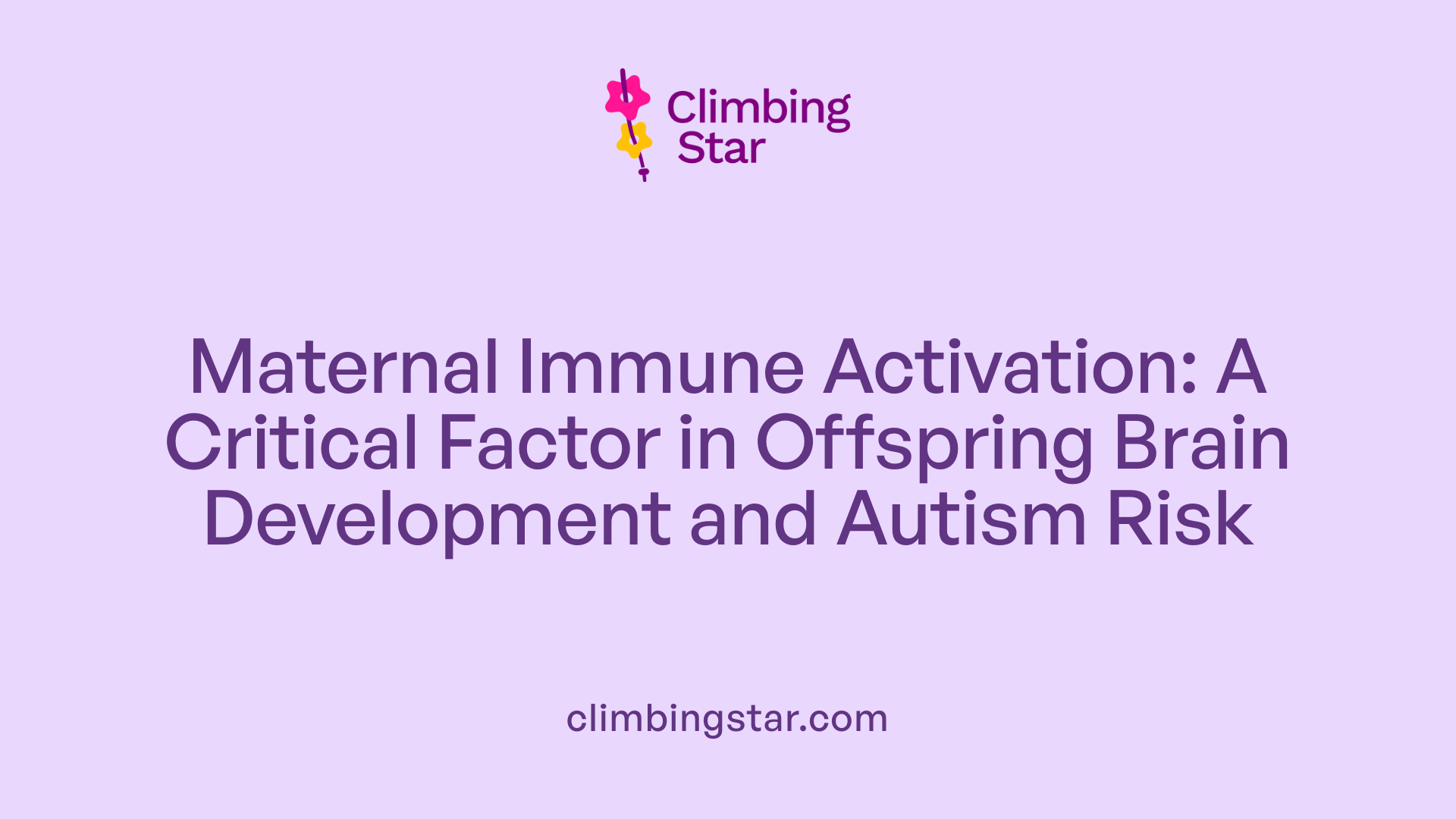
Effects of maternal inflammation on ASD-like behaviors in offspring
Maternal inflammation during pregnancy has been shown to induce behaviors in offspring that resemble those seen in autism spectrum disorder (ASD). This link suggests that immune activation in the mother can disrupt normal neurodevelopmental processes in the fetus, predisposing children to ASD. Such inflammation may trigger changes in fetal brain cell development, altering critical neuronal networks involved in social and cognitive functions.
Preclinical maternal immune activation (MIA) models
Animal studies serve as important models to understand maternal immune activation (MIA). In these preclinical models, immune stimulation during gestation leads to increased production of inflammatory cytokines in both mother and offspring. These models exhibit ASD-relevant behavioral changes and neuroimmune alterations, providing a controlled environment to study mechanisms underlying ASD risk connected to maternal inflammation.
Elevation of inflammatory cytokines during gestation
During maternal immune activation, there is a notable rise in inflammatory cytokines including IL-6 and IL-17A. These cytokines cross the placental barrier or influence fetal brain development indirectly, contributing to neuroinflammation. Elevated cytokine levels in the prenatal environment are linked to disruptions in neuronal maturation and synaptic connectivity important for healthy brain function.
Altered microglia and neuroimmune interactions due to maternal inflammation
Maternal inflammation impacts the offspring's brain immune cells, particularly microglia, which are critical for synaptic pruning and maintaining neural homeostasis. Altered microglia caused by MIA can contribute to neuroinflammatory states and aberrant neural circuit formation associated with ASD. These changes highlight the importance of neuroimmune interactions in the developing brain influenced by maternal immune status.
The Kynurenine Pathway: Linking Inflammation to Neurodevelopmental Disruptions in ASD
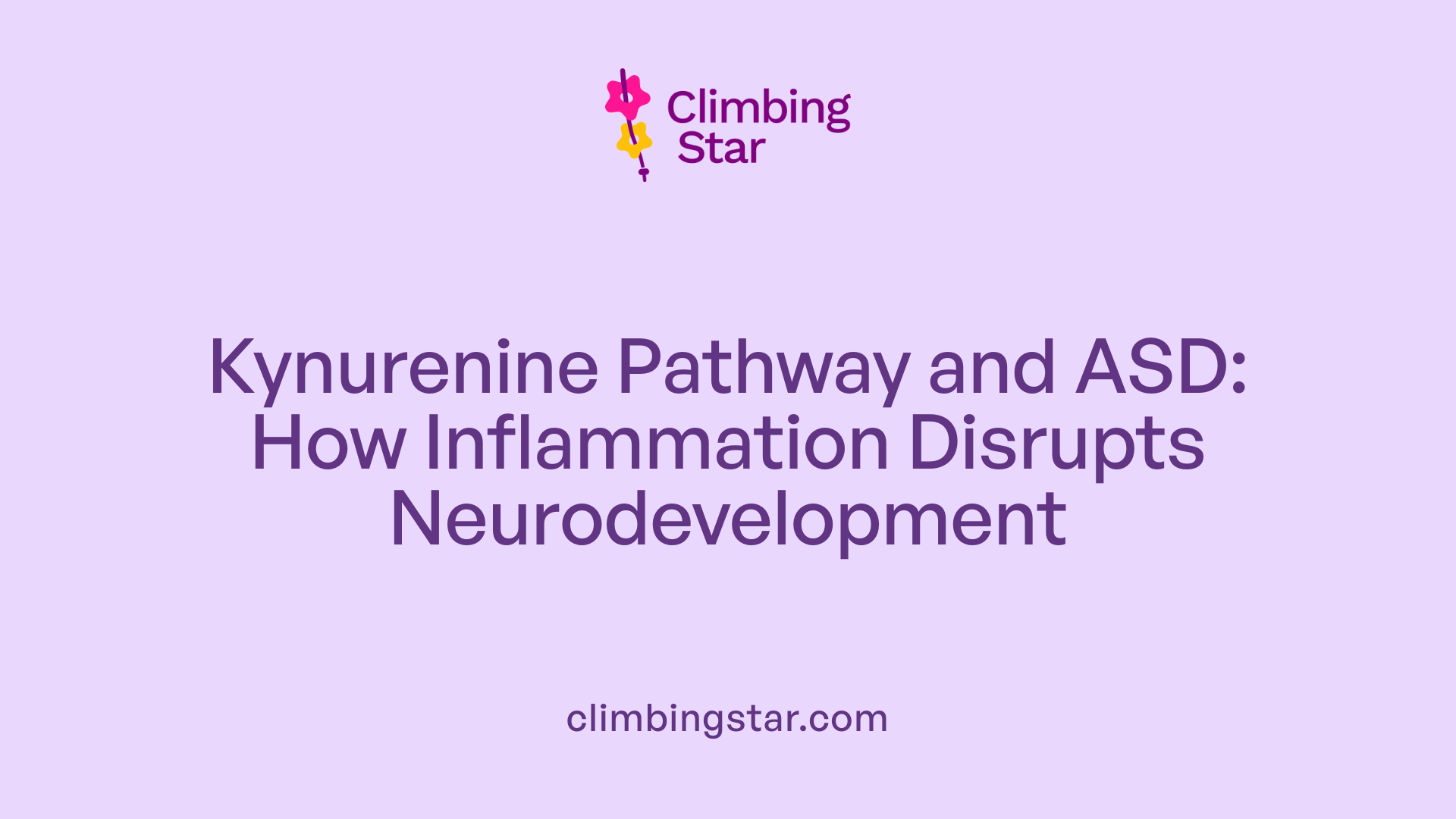
What is the role of the kynurenine pathway (KP) in tryptophan metabolism?
The kynurenine pathway is the primary route for the metabolism of tryptophan, accounting for over 95% of its breakdown. This metabolic route produces several neuroactive compounds that influence neurotransmission in the brain. These metabolites include kynurenine, kynurenic acid, and quinolinic acid, which have distinct effects on neural function.
How does inflammation affect the kynurenine pathway and its neuroactive metabolites?
Inflammation upregulates the KP, resulting in altered production of its metabolites. Increased activity of this pathway can lead to elevated levels of neurotoxic compounds like quinolinic acid and shifts in the balance of neuroprotective and neurotoxic metabolites. Such changes have been linked to neurobehavioral deficits including impairments in depression, anxiety, and cognitive functions.
What altered KP metabolite levels are observed in children with ASD?
Children with autism spectrum disorder show notable changes in KP metabolites. Studies report increased kynurenine and quinolinic acid levels alongside decreased kynurenic acid, suggesting a skew towards neurotoxicity and disrupted neurotransmission. These alterations align with evidence of neuroinflammation and are consistent with observed behavioral and developmental symptoms in ASD.
How does prenatal inflammation modify KP metabolism leading to behavioral deficits?
Prenatal exposure to inflammation during critical developmental windows can influence KP metabolism profoundly. Experimental models demonstrate that such inflammation increases kynurenine pathway activation in the fetus, which disrupts normal brain development. This disturbance results in behavioral deficits typically associated with ASD, such as social impairments and cognitive challenges. Manipulations targeting KP metabolism during pregnancy can impact offspring neurodevelopment, highlighting a mechanistic link between inflammation and ASD vulnerable periods.
This connection between inflammation, KP dysregulation, and neurodevelopment emphasizes the importance of understanding immune-metabolic pathways as potential targets for therapeutic intervention in ASD.
| Topic | Details | Impact on ASD |
|---|---|---|
| Kynurenine Pathway (KP) | Major tryptophan metabolism route creating neuroactive metabolites | Produces compounds influencing neural communication |
| Inflammation and KP | Upregulates KP, altering levels of neurotoxic and neuroprotective metabolites | Promotes neuroinflammation, contributing to behavioral symptoms |
| KP Metabolite Changes in ASD | Elevated kynurenine and quinolinic acid; reduced kynurenic acid | Reflects neuroinflammatory status and neurotransmission imbalance |
| Prenatal Inflammation Effects | Modifies KP metabolism during fetal brain development | Leads to ASD-related behavioral deficits and cognitive disruptions |
Inflammation’s Role in Neurochemical and Synaptic Connectivity Changes in ASD
How Does Inflammation Influence Gene Expression and Brain Energy Metabolism in ASD?
Inflammation during critical periods of brain development leads to gene expression changes that can disturb normal cellular functions. These changes affect brain energy metabolism, resulting in altered neuronal bioenergetics essential for healthy brain maturation. When inflammatory processes are active, gene pathways related to energy production may be dysregulated, compromising the brain’s capacity to sustain neuronal growth and performance.
What Is the Impact of Inflammation on Synaptic Connectivity and Neuronal Function?
The disruption of gene expression and energy metabolism has direct consequences on synaptic connectivity. Research shows that inflammation interferes with the maturation of key neuron types, such as Purkinje and Golgi neurons in the cerebellum, which are critical for motor control, social communication, and emotional regulation.
Synaptic connectivity impairment includes reduced synapse formation and altered synaptic signaling efficiency. These changes diminish neuronal network integration and communication, potentially explaining some neurodevelopmental disruptions observed in ASD. The weakening of synaptic connections hampers the brain’s ability to process information effectively, contributing to ASD symptoms.
How Do Inflammatory Cytokines Interact with Neurotransmission in ASD?
Inflammatory cytokines, such as IL-6, IL-8, and TNF-α, not only signal immune responses but also modulate neurotransmitter systems. Elevated or dysregulated cytokine levels in individuals with ASD affect neurotransmission by altering the balance of excitatory and inhibitory signals. This can lead to inappropriate neuronal activation or suppression.
Moreover, the kynurenine pathway, upregulated by inflammatory signals, produces metabolites that are neuroactive and can impact neurotransmitter receptor activity. These neurochemical changes disrupt normal synaptic communication and plasticity, influencing behavioral outcomes related to ASD.
Understanding these inflammation-driven alterations in gene expression, energy metabolism, and neurotransmitter interactions is crucial for developing targeted therapies aiming to restore synaptic function and improve neurodevelopmental outcomes in ASD.
Innate Immune Dysfunction in Autism: Cellular and Molecular Insights
Increased Peripheral Inflammatory Cytokines in ASD
Autism spectrum disorder (ASD) has been consistently associated with elevated levels of inflammatory cytokines in the blood, including IL-1β, IL-6, and TNF-α. These cytokines are central to initiating and sustaining inflammatory responses and their increased presence suggests an active peripheral innate immune activation in individuals with ASD. Such heightened cytokine levels may contribute to neuroinflammation implicated in ASD pathology.
Altered Innate Immune Cell Numbers and Activation
In addition to altered cytokine profiles, changes in the composition and function of innate immune cells have been observed in ASD. Specifically, increased numbers of monocytes and natural killer (NK) cells have been reported. These cells exhibit dysregulated activation patterns, which leads to abnormal cytokine production. This dysregulation can disturb immune homeostasis and potentially exacerbate neuroinflammatory processes relevant to ASD.
Impact of Dysregulated Cytokine Production on Neuroinflammation
The aberrant production of cytokines by innate immune cells is thought to shape the neuroinflammatory milieu seen in ASD. Dysregulated cytokine signaling influences microglial activation and promotes an inflammatory environment that can interfere with normal neurodevelopment. These immune disruptions may impair synaptic connectivity and neuronal function, providing a mechanistic link between peripheral immune dysfunction and central nervous system anomalies observed in ASD.
Together, these findings emphasize a complex innate immune dysfunction in ASD characterized by increased peripheral inflammation, altered innate immune cell dynamics, and cytokine imbalances that collectively contribute to neuroinflammation and neurodevelopmental challenges.
Clinical and Preclinical Evidence Linking Neuroinflammation to ASD Etiology

Repeated findings of innate immune abnormalities in ASD cases
Research consistently reveals innate immune system abnormalities in individuals with autism spectrum disorder (ASD). Increased peripheral levels of pro-inflammatory cytokines such as IL-1β, IL-6, and TNF-α, as well as elevated chemokines like MCP-1 and RANTES, suggest ongoing innate immune activation in ASD patients. Additionally, alterations in innate immune cell populations—including monocytes, natural killer (NK) cells, and dendritic cells—have been reported, often showing dysregulated activation patterns and cytokine production. Postmortem studies of ASD brains further document microglial activation, increased microglial density, and morphological changes indicative of neuroinflammation.
Transcriptomic upregulation of NF-κB, IL1R1, and cytokine signaling pathways in ASD brain
Molecular analyses of postmortem ASD brain tissues demonstrate significant upregulation of immune-related pathways at the transcriptomic level. Notably, genes involved in NF-κB signaling, IL1R1 (the interleukin-1 receptor type 1), and broader cytokine signaling pathways are highly expressed compared to neurotypical controls. This enhanced transcriptomic activity underlines a neuroinflammatory environment within the brains of ASD individuals, which may disturb neural networks and contribute to the behavioral and cognitive features of ASD.
Preclinical models replicating neuroimmune activation and behavioral changes
Preclinical animal models have been instrumental in linking maternal immune activation (MIA) to ASD-like outcomes. Maternal exposure to immune challenges during gestation leads to elevated inflammatory cytokines, activation of microglia, and lasting changes in neurodevelopment in offspring. These models often demonstrate behavioral phenotypes reminiscent of ASD, including altered social interaction and repetitive behaviors. The neuroimmune activation observed aligns with findings in human studies, reinforcing the hypothesis that early immune dysregulation is a critical factor in ASD etiology. Collectively, these models provide a controlled framework for dissecting mechanistic links between inflammation and neurodevelopmental disturbances in ASD.
Neuroimmune Interactions and Cytokine Profiles in Cerebrospinal Fluid of ASD Patients

Elevated inflammatory cytokines in ASD cerebrospinal fluid
Research has identified significantly elevated levels of various inflammatory cytokines in the cerebrospinal fluid (CSF) of patients with autism spectrum disorder (ASD). Notably, cytokines such as TNF-α, IL-4, IL-21, IL-31, IL-5, BAFF, and APRIL show increased concentrations compared to controls. This elevation underscores an ongoing neuroinflammatory state and immune dysfunction within the central nervous system (CNS) of individuals with ASD. These neuroimmune alterations may play a crucial role in the development and manifestation of ASD symptoms.
Cytokine profile comparison between ASD and cerebral palsy (CP)
Comparative analyses between ASD and cerebral palsy (CP) patients reveal distinct cytokine profiles in CSF. CP patients exhibit elevated levels of IFN-γ, GM-CSF, TNF-α, IL-2, IL-4, IL-6, IL-17A, IL-12, and the anti-inflammatory cytokine IL-10. Furthermore, certain growth factors like NGF-β, EGF, GDF-15, G-CSF, and BMP-9 are significantly higher in CP, suggesting differing neuro-immune mechanisms and CNS developmental influences between the two disorders. These contrasts highlight the heterogeneity of neuroinflammatory processes underlying various neurodevelopmental conditions.
Implications for neuroinflammation and ASD pathology
The distinct cytokine alterations observed in ASD CSF point toward chronic neuroinflammation and dysregulated immune responses contributing to ASD pathogenesis. Elevated cytokines such as TNF-α and IL-31 may mediate inflammatory cascades affecting neuronal function and connectivity. Understanding these neuroimmune signatures provides valuable insight into mechanisms by which immune dysregulation impacts brain development and function in ASD, offering avenues for targeted immunomodulatory therapies to potentially ameliorate disease symptoms and progression.
Therapeutic Approaches Targeting Immune Dysregulation in Autism
Experimental Therapies such as Autologous Bone Marrow Mononuclear Cell (BMMNC) Infusion
Autologous bone marrow mononuclear cell (BMMNC) infusion is an emerging experimental therapy explored for managing autism spectrum disorder (ASD). This approach uses the patient’s own bone marrow cells, which are infused back into their system to potentially modulate immune responses and encourage neuroregenerative processes. Clinical observations have suggested that BMMNC infusion may help address the immune dysregulation and neuroinflammation implicated in ASD pathology.
Modulatory Effects on Cytokine Profiles Observed Post-Infusion
Following BMMNC infusion, studies have documented subtle but notable changes in cerebrospinal fluid cytokine profiles among ASD patients. Specifically, a slight decrease in transforming growth factor-beta (TGF-β) levels has been observed 5 to 12 months post-treatment. Since TGF-β is a multifunctional cytokine involved in immune regulation and neurodevelopment, its modulation may reflect a shift toward a more balanced immune environment within the central nervous system. Such cytokine profile adjustments reinforce the potential of BMMNC therapy to influence neuroimmune interactions relevant to ASD.
Potential for Immunomodulation as Complementary ASD Treatment
Given the documented immune dysregulation in ASD—including altered cytokine levels such as IL-10, IL-8, and TNF-α—immunomodulatory therapies hold promise as complementary treatment options. BMMNC infusion and similar approaches aim to restore immune homeostasis, potentially reducing neuroinflammation and supporting healthier brain development and function. While current evidence remains preliminary and requires larger-scale clinical trials, these therapies represent a novel pathway for addressing the underlying immune-related mechanisms contributing to ASD symptoms.
Applied Behavior Analysis (ABA) Therapy: Foundations and Application in Autism Support
What is Applied Behavior Analysis (ABA) therapy, and how is it used to support individuals with autism?
Applied Behavior Analysis (ABA) therapy is a scientifically supported approach focused on understanding and improving behavior through learning principles and environmental influences. It is widely used to support individuals with autism spectrum disorder (ASD) by helping them acquire vital social, communication, academic, and daily living skills.
ABA therapy uses methods like positive reinforcement—rewarding desirable behaviors to increase their frequency—and prompting, which guides individuals to perform targeted behaviors. Central to ABA is the A-B-Cs behavioral model, analyzing the Antecedent (what happens before behavior), Behavior itself, and Consequence (what follows), to shape interventions that fit each individual’s needs.
ABA programs are often structured through approaches such as Discrete Trial Training (DTT) or Pivotal Response Treatment (PRT), tailored and monitored by certified behavior analysts. Early, intensive ABA therapy starting between ages 2 and 6 has demonstrated significant gains in communication and independence.
Modern ABA incorporates naturalistic, play-based techniques encouraging meaningful interaction, promoting respect for individual differences, and ensuring that learning happens in real-life contexts. Overall, ABA therapy aims to enhance quality of life by systematically building skills and reducing behaviors that interfere with functioning.
The Professionals Behind ABA Therapy: Credentials and Expertise

Who typically provides ABA therapy, and what qualifications do these professionals have?
ABA therapy is delivered by a team of trained and credentialed professionals including Board Certified Behavior Analysts (BCBAs), Qualified Behavior Analysts (QABAs), and Registered Behavior Technicians (RBTs).
BCBAs usually hold a master's degree in applied behavior analysis or a related field. They complete extensive supervised practical experience followed by passing a rigorous certification exam administered by the Behavior Analyst Certification Board (BACB). Their advanced training enables them to design, oversee, and evaluate individualized behavioral interventions.
QABAs are certified by the Qualified Autism Service Providers Association and often have credentials similar to BCBAs, but the certification requirements can vary.
RBTs are paraprofessionals who provide direct one-on-one therapy under supervision. They generally hold at least a high school diploma, complete a specific training program, and pass a competency assessment to become certified. Their role is essential in implementing therapeutic interventions consistently in varied settings.
Educational and licensure requirements including supervised practical experience
Practitioners aspiring to provide ABA therapy must meet state educational requirements, complete supervised fieldwork, and obtain certifications. For example, BCBAs complete over 1,500 hours of supervised experience before sitting for certification exams. RBTs complete 40 hours of training and competency evaluations.
Certification and licensure process in states like Texas
In Texas, providers must obtain licensure from the Texas Department of Licensing & Regulation (TDLR). This process requires fulfilling education criteria, documenting supervised experience hours, and passing certification exams recognized by regulatory bodies such as the BACB or QABA. This ensures that ABA practitioners meet standardized professional and ethical standards.
Overall, the qualifications of ABA therapy providers ensure they possess the expertise needed to deliver evidence-based, ethical, and effective interventions tailored to individuals with autism spectrum disorder and related developmental conditions.
Core Objectives and Outcomes of ABA Therapy in Autism Treatment

What are the key goals and outcomes that ABA therapy aims to achieve in treating autism?
ABA (Applied Behavior Analysis) therapy focuses on several essential areas to support individuals with autism. It aims to improve communication skills, enabling better expression of needs and thoughts, which is foundational for social interaction.
Social skills development is another major target, helping individuals engage more effectively with peers and caregivers. Equally important are enhancements in daily living skills such as personal hygiene, dressing, and feeding, fostering greater independence.
Academic abilities are also addressed, with ABA therapists working to support learning that can improve performance and enjoyment in educational settings. The therapy seeks to increase adaptive behaviors—those useful and functional for everyday life—while reducing challenging or harmful behaviors by using techniques like positive reinforcement.
Goals in ABA are always tailored to the unique needs of the individual, recognizing that every person with autism has different strengths and areas for growth. This personalized approach helps maximize the individual's independence and overall quality of life.
Research shows that with consistent, intensive ABA therapy, individuals often show significant progress across multiple developmental domains, enabling greater participation in community activities and improving lifelong outcomes.
Structuring ABA Therapy: Assessments, Interventions, and Family Involvement

What does a typical ABA therapy treatment plan involve?
A comprehensive ABA therapy treatment plan begins with a thorough assessment phase. This includes detailed observations and a Functional Behavior Assessment (FBA) to identify the specific behaviors and learning needs of the individual. Family members also provide valuable input to create a well-rounded understanding of the child's abilities, challenges, and environment.
Following this assessment, therapists develop personalized goals targeting important areas like skill development, communication, social interaction, and reduction of challenging behaviors. These goals guide the selection of evidence-based teaching strategies such as discrete trial training (DTT) and pivotal response training (PRT).
Interventions employ positive reinforcement to encourage desired behaviors, teach alternative responses to replace problematic behaviors, and establish consistent routines. These techniques are applied in both structured settings and natural environments to promote generalization of skills.
Progress is carefully tracked through ongoing data collection, enabling therapists to monitor effectiveness and make timely adjustments to treatment plans. This dynamic approach ensures that interventions stay aligned with the individual's evolving needs.
Crucially, family involvement is emphasized to maintain consistency across home, school, and therapy settings. Caregivers receive training and support to implement strategies consistently, strengthening learning outcomes and enhancing everyday functioning.
Critiques and Ethical Considerations of ABA Therapy within the Autism Community

Are there any controversies or criticisms associated with ABA therapy in the autism community?
Applied Behavior Analysis (ABA) therapy, while widely used to support autistic individuals, has sparked significant controversy within the autism community. Many concerns focus on the therapy’s emphasis on behavior normalization, where modifying autistic behaviors to align with neurotypical standards may lead to emotional distress or even trauma.
Historically, some ABA practices included aversive techniques such as electric shock, which have been abandoned in modern ethical guidelines. Despite this, there remains debate over the use of certain punishment or extinction methods still employed in some settings, raising ethical questions about the potential harm to clients.
Critics also highlight how ABA may encourage masking—the suppression of natural autistic traits—to help individuals conform socially. This forced behavioral control can risk undermining an autistic person’s authentic identity and may contribute to burnout or negative mental health outcomes.
Ongoing efforts within the field seek to reform ABA to be more developmentally appropriate, respectful, and centered on each individual’s unique needs. Emphasizing positive reinforcement, family collaboration, and support for autistic self-advocacy aims to reduce past harms and improve the therapy’s ethical standing.
Overall, while ABA can provide benefits when carefully and compassionately applied, it is crucial to recognize and address the objections raised by many in the autism community to foster more humane and effective interventions.
The Complexity and Heterogeneity of Inflammatory Responses in ASD
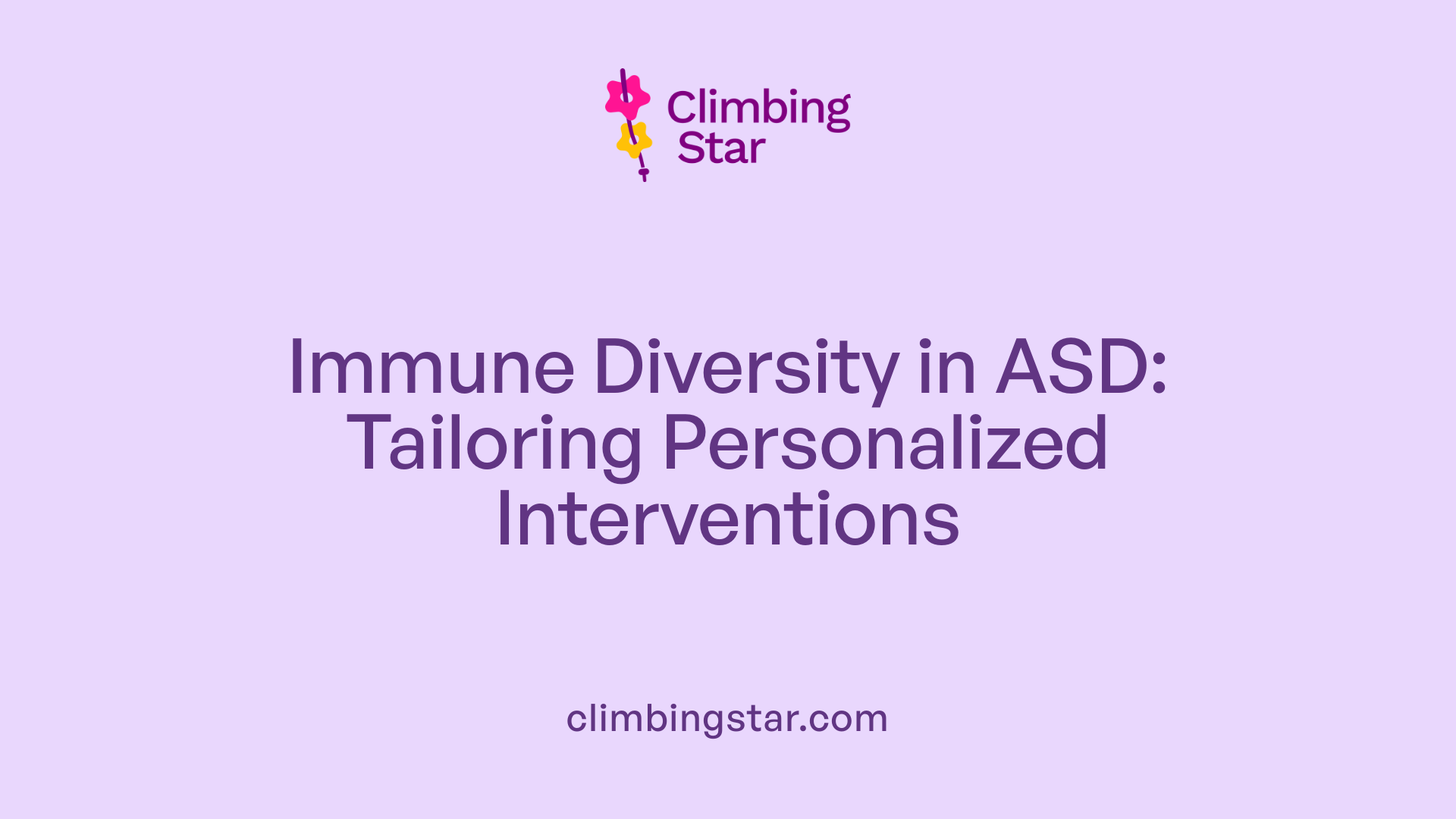
Not all immune responses in ASD are pro-inflammatory
Autism spectrum disorder (ASD) is associated with altered immune function, but these immune changes are not uniformly pro-inflammatory. Research indicates that cytokine profiles in ASD are complex and heterogeneous. For instance, while some pro-inflammatory cytokines like TNF-α and IL-6 are elevated in many cases, others such as IL-8 may be reduced. Moreover, anti-inflammatory cytokines like IL-10 are often found at lower serum levels in ASD patients, suggesting impaired immune regulation rather than a simple increase in inflammation.
Diverse cytokine patterns including IL-6, TNF-α, TGF-β involvement
Multiple cytokines are involved in the immune-neuro interactions observed in ASD. IL-6 and TNF-α are commonly elevated pro-inflammatory markers linked to neuroinflammation and neurodevelopmental disruption. Meanwhile, TGF-β, an important modulator of immune response and central nervous system development, also shows altered levels in ASD. This diversity in cytokine expression points to a multifaceted immune dysregulation that affects both innate and adaptive immune pathways and contributes to ASD pathogenesis.
Implications for personalized immunological profiling
Given the heterogeneity of immune responses in ASD, immunological profiling could facilitate more precise diagnosis and tailored therapeutic approaches. Identifying distinct cytokine signatures may help stratify patients into subgroups with different underlying immune dysregulation patterns. This could improve the prospects for immunomodulatory treatments targeting specific immune pathways, enhancing efficacy and minimizing side effects. Consequently, personalized immunological assessment emerges as a promising avenue in ASD research and clinical care.
Environmental and Genetic Factors Influencing Immune Dysfunction in Autism
How does maternal autoimmunity and immune activation during pregnancy influence ASD?
Maternal immune activation (MIA) during gestation significantly impacts the risk of autism spectrum disorder (ASD) in offspring. Studies show that inflammation during pregnancy, such as maternal autoimmunity or infections leading to immune activation, alters fetal brain development. MIA elevates inflammatory cytokines like IL-6 and IL-17A, which can disrupt neurodevelopment through microglial activation and altered neural connectivity. Preclinical maternal immune activation models demonstrate that offspring exhibit ASD-like behaviors linked to cytokine-induced neuroinflammation.
What genetic predispositions affect innate immunity related to ASD?
Genetic factors influencing innate immune function also contribute to ASD susceptibility. Variations in genes regulating cytokine signaling pathways and immune cell activation can lead to dysregulated inflammatory responses. Transcriptomic analyses of ASD brains reveal upregulated immune-related pathways (e.g., NF-κB, IL1R1). Altered innate immune cell populations such as increased monocytes, natural killer cells, and dendritic cells suggest a heritable component in immune dysregulation that affects neuroinflammation and cytokine production relevant to ASD pathogenesis.
How do environmental and genetic factors combine to affect ASD risk through immune dysfunction?
An interplay between environmental exposures and genetic predispositions creates a multifactorial immune etiology for ASD. Environmental factors like prenatal infections can trigger maternal immune activation, while genetic susceptibilities influence how the innate immune system responds. This combined effect elevates neuroinflammation, disrupts cytokine balance, and modifies critical neurodevelopmental pathways. The resulting altered immune network interactions and neuroinflammatory cascades increase the likelihood of ASD, highlighting the importance of studying both environmental and genetic contributors to immune dysfunction in this disorder.
| Factor Type | Examples | Impact on Immune Dysfunction in ASD |
|---|---|---|
| Environmental | Maternal infections, autoimmune diseases | Activation of inflammatory cytokines during gestation; microglial changes in fetal brain |
| Genetic | Variants in cytokine signaling genes; immune regulation pathways | Dysregulated innate immune responses; altered cytokine production and immune cell function |
| Combined Effects | Gene-environment interactions | Enhanced neuroinflammation; disrupted neurodevelopment; increased ASD risk |
Linking Early Childhood Brain Inflammation to Later Neurodevelopmental Disorders

Why is inflammation considered a risk factor for autism and schizophrenia?
Early childhood brain inflammation is increasingly recognized as a significant risk factor for neurodevelopmental disorders such as autism spectrum disorder (ASD) and schizophrenia. Studies show that inflammation during critical developmental periods disrupts normal brain maturation, heightening vulnerability to these conditions. For instance, inflammation caused by infections in early life has been linked to altered development of brain regions crucial for cognitive and emotional functions.
How does inflammation affect brain cell development and synaptic formation?
Research using postmortem brain tissues of children aged 1 to 5 years reveals that inflammation specifically impairs the maturation of Golgi and Purkinje neurons in the cerebellum. The cerebellum plays a vital role in motor control, language, social skills, and emotion regulation. Purkinje neurons form essential synaptic connections with other brain areas involved in cognition and emotion, while Golgi neurons coordinate communication within the cerebellum.
When inflammation alters gene expression during critical phases of development, it leads to premature disruption of these neurons. This results in reduced synaptic connectivity and disturbed energy metabolism, contributing to the neurobehavioral deficits observed in ASD and schizophrenia.
Are there potential windows for intervention during early life?
Because the cerebellum develops early and remains plastic during childhood, early-life inflammation presents a potential window for therapeutic intervention. Understanding how inflammation disturbs brain cell maturation opens avenues for targeted strategies aimed at minimizing neuronal disruption.
By focusing on immunomodulation and protecting vulnerable neuronal populations like Purkinje and Golgi neurons, it may be possible to reduce the risk or severity of neurodevelopmental disorders. Early detection and anti-inflammatory therapies during critical developmental periods could improve long-term neurobehavioral outcomes.
| Aspect | Details | Significance |
|---|---|---|
| Inflammation as a risk factor | Early infections and inflammatory states increase ASD and schizophrenia risk | Highlights importance of managing inflammation in early childhood to prevent disorders |
| Brain cells affected | Golgi and Purkinje neurons in cerebellum show disrupted maturation during inflammation | Explains link between inflammation and impaired motor, cognitive, and emotional regulation |
| Synaptic and metabolic impact | Altered gene expression reduces synaptic connectivity and affects energy metabolism | Contributes to understanding neurobehavioral symptoms in ASD and schizophrenia |
| Intervention window | Early childhood offers plasticity for potential therapies targeting immune and neuronal health | Emphasizes need for early diagnosis and treatment to mitigate adverse neurodevelopmental effects |
Molecular Pathways Implicated in Autism-related Neuroinflammation
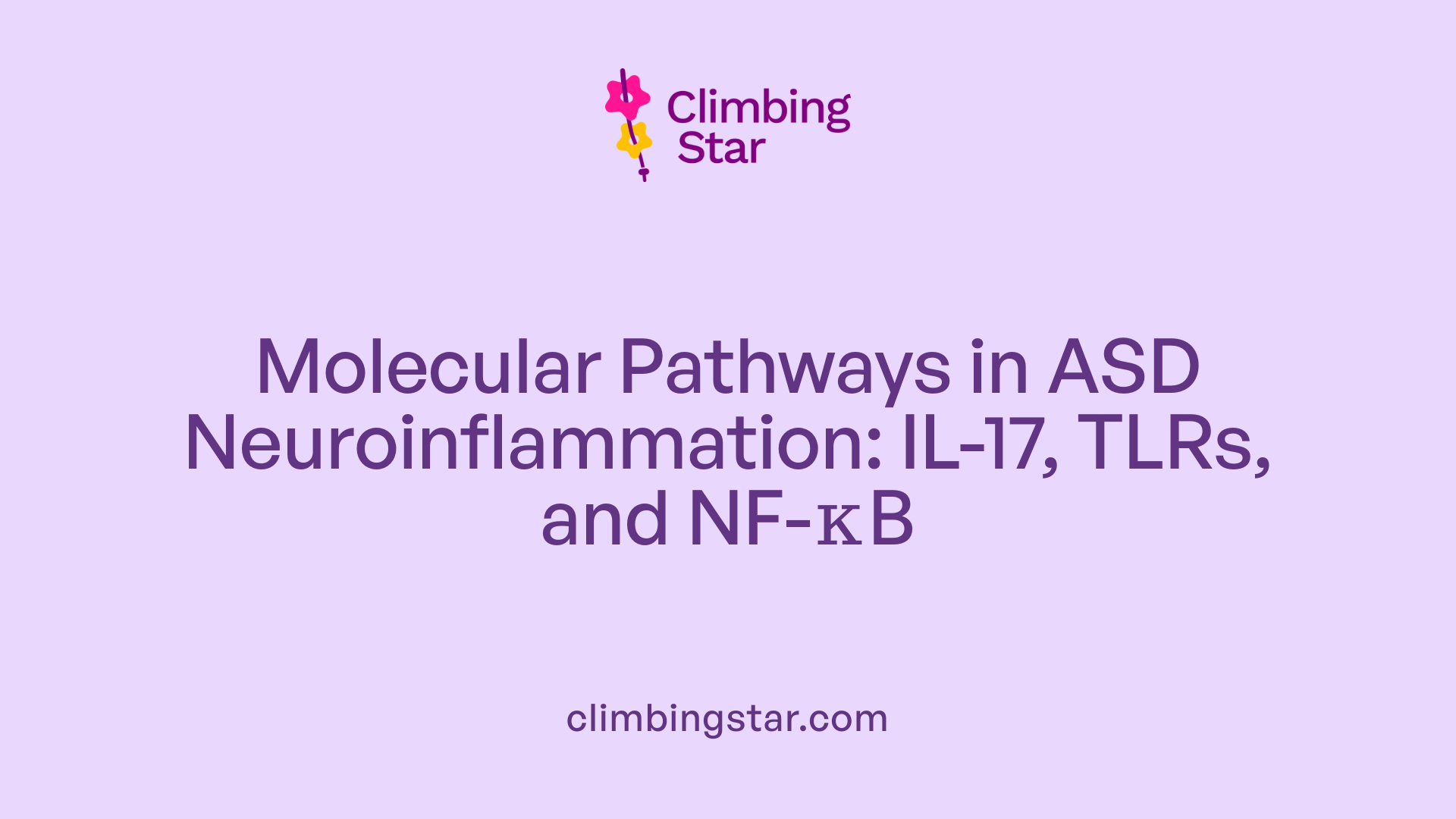
What are the IL-17 signaling pathway and its role in ASD?
The IL-17 signaling pathway is crucial in mediating immune responses, particularly inflammation. In autism spectrum disorder (ASD), multiple inflammation-related proteins—including IL-17C—are upregulated, implicating this pathway in the disorder. Elevated IL-17 signaling can promote the production of pro-inflammatory cytokines, affecting neurodevelopment and potentially contributing to ASD pathology.
How does Toll-like receptor (TLR) signaling contribute to neuroinflammation in ASD?
Toll-like receptors (TLRs) are immune receptors recognizing microbial molecules and triggering innate immune responses. In ASD, TLR signaling is involved in activating inflammatory cascades in the brain and periphery. Activation of TLR pathways can enhance cytokine production, including IL-6 and TNF-α, which are frequently elevated in children with ASD. This signaling contributes to sustained neuroinflammation, influencing neuronal function and neurodevelopment.
What role do NF-κB and cytokine–cytokine receptor interaction pathways play in ASD-related inflammation?
The NF-κB pathway is a central regulator of inflammatory gene expression. Transcriptomic analyses reveal its upregulation in ASD brains, indicating active inflammation-related signaling. NF-κB often acts downstream of TLR activation, resulting in increased transcription of cytokines such as IL-1β and TNF-α. Additionally, cytokine–cytokine receptor interactions are altered in ASD, driving dysregulated immune responses and affecting neuroinflammatory processes essential in ASD pathogenesis.
These pathways collectively highlight the complex immune network disruptions in ASD neuroinflammation. Their modulation may offer therapeutic avenues for treating immune-related dysfunctions in ASD.
Future Directions: Towards Targeted Therapies Based on Immune Signatures in ASD
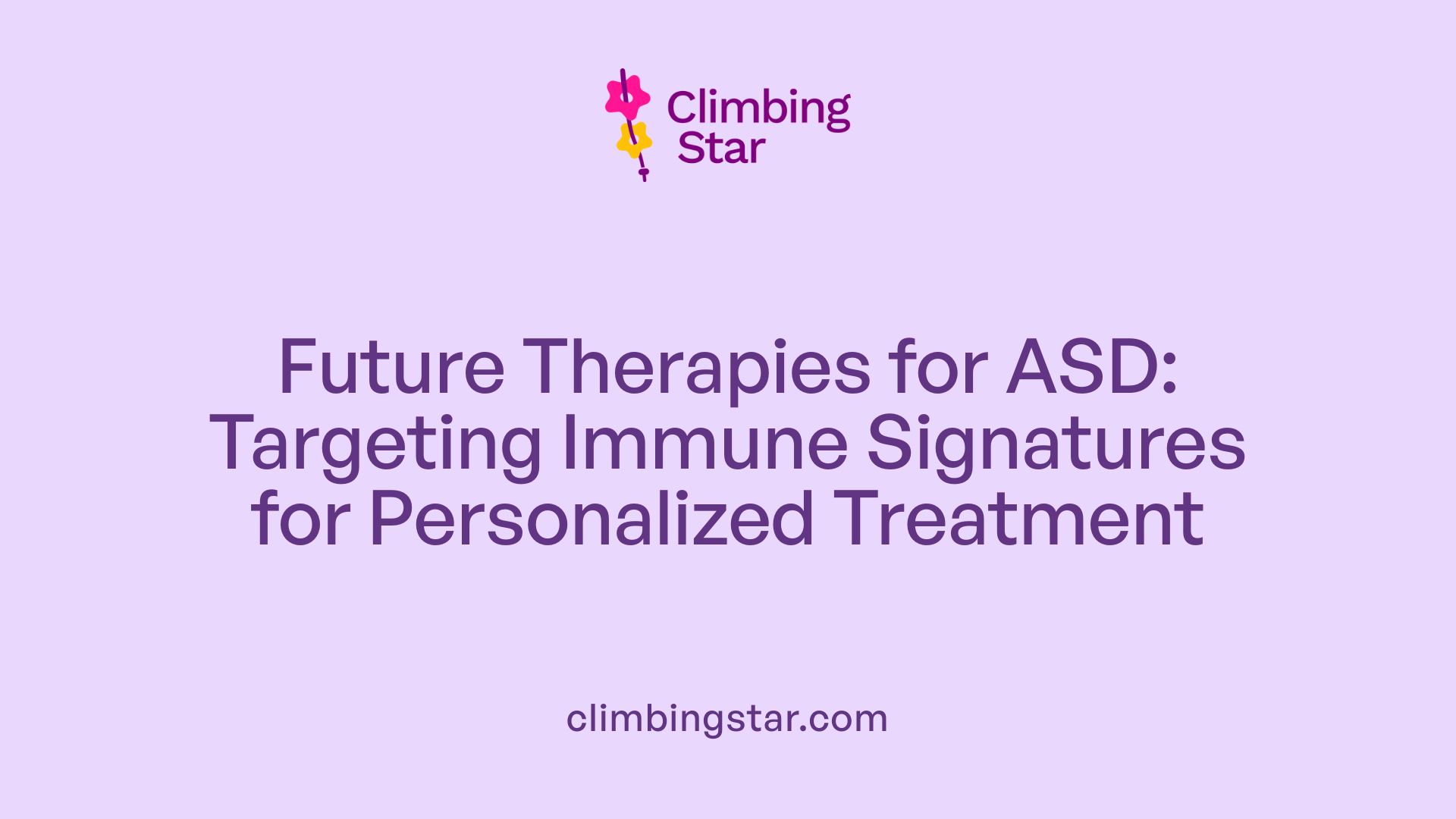
Identifying immune profiles for subgroup stratification
Research increasingly illustrates that autism spectrum disorder (ASD) is associated with complex and heterogeneous immune responses. Distinct cytokine and chemokine alterations, such as lower IL-10, altered IL-8, and elevated TNF-α and IL-17C levels, reveal diverse immune network interactions within ASD populations. This variability suggests the presence of immune subgroups among ASD individuals, underpinning the need to identify specific immune profiles that may aid in patient stratification and focused treatment planning.
Potential for personalized immunotherapies
The recognition of unique cytokine signatures in ASD opens avenues for personalized immunotherapies. Biomarkers like IL-10 and IL-17C demonstrate high diagnostic potential, indicating that targeting dysregulated inflammatory pathways could improve therapeutic outcomes. Personalized approaches might involve modulating cytokine levels or immune cell functions, aiming to restore balanced neuroimmune interactions and potentially ameliorate neuroinflammation-linked symptoms.
Need for more mechanistic studies linking inflammation and ASD
Although there is robust correlational evidence connecting immune dysregulation and ASD, mechanistic insights remain limited. Further research is crucial to clarify how inflammation alters neuronal development, as seen in studies of cerebellar Purkinje and Golgi neurons, and the kynurenine pathway's role in neuroactive metabolite production. Understanding these mechanisms could inform the design of targeted interventions that modify the underlying immune-related pathology rather than just symptoms.
Integration of immune modulation with behavioral therapies
Future treatment frameworks are likely to integrate immunomodulation with conventional behavioral and developmental interventions. Such holistic strategies might address both the biological and behavioral aspects of ASD, maximizing therapeutic efficacy. Immune-targeted therapies could potentially complement behavioral therapies by reducing neuroinflammation, thereby facilitating better cognitive and social outcomes.
This evolving landscape emphasizes the need for multidisciplinary approaches combining immunology, neurobiology, and clinical care to improve the lives of individuals with ASD.
Bridging Behavioral and Biological Approaches in Autism Support
Complementary role of immunomodulatory treatments and ABA therapy
Autism spectrum disorder (ASD) involves complex interactions between immune dysfunction and behavioral challenges. While Applied Behavior Analysis (ABA) therapy remains a cornerstone for managing behavioral symptoms in ASD, emerging evidence highlights the potential benefits of incorporating immunomodulatory treatments. These treatments aim to address the underlying immune dysregulation observed in many individuals with ASD, such as altered cytokine profiles and neuroinflammation, which standard behavioral interventions do not target.
Holistic strategies addressing both immune dysfunction and behavioral challenges
Holistic management of ASD acknowledges that behavioral symptoms and immune abnormalities are intertwined. Immunomodulatory approaches, including therapies that regulate cytokines and neuroinflammation, can potentially improve neurological function and thereby enhance behavioral therapy outcomes. For example, therapies focusing on reducing pro-inflammatory cytokines like TNF-α and modulating anti-inflammatory cytokines such as IL-10 may create a more favorable neurobiological environment for learning and social interaction.
Potential benefits of integrated therapeutic planning
Integrating immunomodulatory treatments with behavioral therapies like ABA could offer synergistic effects. By simultaneously targeting immune dysregulation and behavioral challenges, comprehensive therapeutic plans may improve social responsiveness, communication skills, and cognitive functions more effectively than either approach alone. This alignment supports the move toward personalized and precision medicine in ASD, emphasizing tailored interventions that reflect individual biological and behavioral profiles for optimal outcomes.
Integrating Insights on Inflammation and Autism for Enhanced Care
The accumulation of research underscores the crucial role of immune dysfunction and neuroinflammation in the etiology of autism spectrum disorder. Altered cytokine profiles, disrupted neuronal development, and immune cell dysregulation form a complex biological foundation for ASD, complementing the behavioral characteristics traditionally targeted by therapies. Applied Behavior Analysis remains a cornerstone of autism intervention, focusing on skill development and behavioral support. Increasingly, a multidimensional treatment paradigm that integrates immunological understanding with tailored behavioral therapies promises enhanced diagnostic precision and personalized care. Future advances in identifying immune biomarkers and targeted immunomodulatory treatments could considerably improve outcomes. Embracing both biological and behavioral perspectives fosters a more comprehensive, compassionate approach to supporting individuals with autism and their families.
References
- Correlation of biochemical markers and inflammatory ...
- New Research Shows How Brain Inflammation in Children ...
- Novel Inflammatory Biomarkers for Autism Spectrum Disorder ...
- Innate Immune Dysfunction and Neuroinflammation in ...
- Does the kynurenine pathway play a pathogenic role in ...
- Inflammatory mediators drive neuroinflammation in autism ...
- Study shows impact of inflammation on the developing brain







